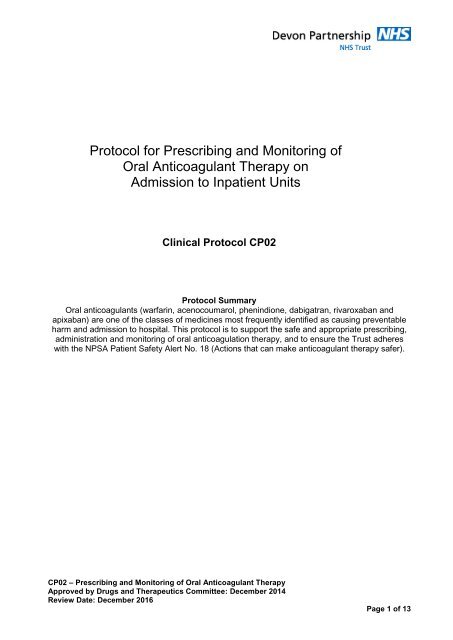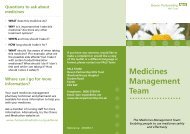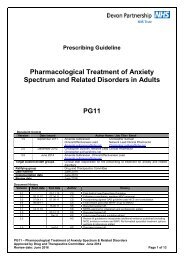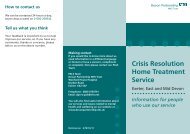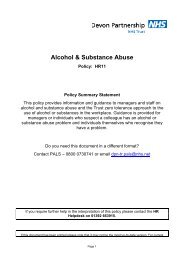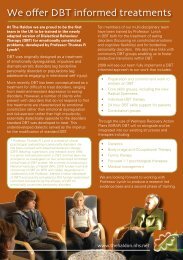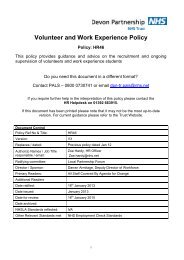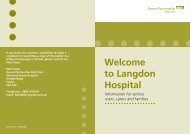CP02 Oral Anticoagulant Therapy - Devon Partnership NHS Trust
CP02 Oral Anticoagulant Therapy - Devon Partnership NHS Trust
CP02 Oral Anticoagulant Therapy - Devon Partnership NHS Trust
Create successful ePaper yourself
Turn your PDF publications into a flip-book with our unique Google optimized e-Paper software.
Document ControlVersion Date Issued Author Name / Job Title / Email1.0 January 2010 Amanda GulbransonClinical Effectiveness Lead - Medicine Managementamanda.gulbranson@nhs.net2.03.0November 2012December 2014Christopher SullivanNetwork Lead Clinical PharmacistChristopher.sullivan@nhs.netTarget audience/ staff groups: Clinical staff: All inpatient staff responsible for the prescribing andmonitoring of anticoagulation treatmentRatifying Group:Medicines Management Governance GroupDate ratified: December 2014Implementation date: December 2014Review date: December 2016Document HistoryVersion Start date End date Author History1.0 April 2010 AG New protocol1.1 May 2012 Sept 12 CS No response to consultationDose titration regimes brought into line with local <strong>Trust</strong>protocolsAdmin chart and initiation checklist separated1.2 Oct 12 Nov 12 CS Section added to form to log if there is a yellow book.Details of information to be added to RiO included. Needto complete DATIX form for high INR (>5) added.1.3 Nov 12 CS Added comment re: new anticoagulants, amended adminform to reflect learning from incidents2.0 Nov12 KS Document ratified at November MMGG.2.0 Jan13 KS Advised to get chart from Medicines Management notEROS.2.1 Nov-14 Dec14 CS Routine review. Updated info on approved indications fornew oral anticoagulants in line with local formularies3.0 Dec14 KS Document signed off.<strong>CP02</strong> – Prescribing and Monitoring of <strong>Oral</strong> <strong>Anticoagulant</strong> <strong>Therapy</strong>Approved by Drugs and Therapeutics Committee: December 2014Review Date: December 2016Page 2 of 13
Protocol for Prescribing and Monitoring of <strong>Oral</strong> <strong>Anticoagulant</strong><strong>Therapy</strong> on Admission to Inpatient Units1. Introduction<strong>Anticoagulant</strong>s are one of the classes of medicines most frequently identified as causingpreventable harm and admission to hospital. This protocol is to support the safe and appropriateprescribing, administration and monitoring of oral anticoagulation therapy, and to ensure the <strong>Trust</strong>adheres with the NPSA Patient Safety Alert No. 18 (Actions that can make anticoagulant therapysafer).There are two classes, older coumarin-based medicines (warfarin, acenocoumarol, phenindione)which require INR monitoring and newer oral anticoagulants that do not require INR monitoring(dabigatran, rivaroxaban and apixaban)The main focus of this protocol relates to the safe prescribing of warfarin and relatedanticoagulants.1.1 Apixaban, Dabigatran and RivaroxabanThe oral anticoagulants apixaban, dabigatran and rivaroxaban have been approved by localarea prescribing committees for use in atrial fibrillation as equal first line with warfarin inaccordance with NICE technology appraisals. They are associated with an increased risk ofbleeding and prescribers in mental health settings need to be aware of this when prescribingthese medicines. They should only be initiated following consultation with ahaematologist/specialist in atrial fibrillation. In addition rivaroxaban is approved for use intreating DVTs and preventing recurrent DVTs and pulmonary embolism.Dabigatran is contraindicated in severe renal impairment. Dose reductions for both anticoagulantsare required in renal impairment. Renal function should be monitored at least annually in peopleolder than 75 years and in indiviudals with renal impairment.In order to minimise the risk from inappropriate treatment it is recommended that everyone takingthe new drugs receive a patient safety alert card and are advised to carry this with them and showto any healthcare professionals providing treatment.Both patient safety alert cards are available from Medicines Management (telephone 01392675674) or by contacting the manufacturers.Pradaxa® (dabigatran) patient alert cards available to order from Boehringer Ingelheim atwww.pradaxa.co.ukEliquis® (apixaban) Patient alert card is in the medication boxXarelto® (rivaroxaban) patient alert cardsThere are three Xarelto® leaflets available (DVT, AF and post hip and knee surgery) whichall contain the generic patient alert card. The alert cards are not currently availablewithout ordering the entire leaflet. Leaflets can be ordered from Bayer HealthCare bytelephoning 01635 563000 (Medical Information) or online at www.xarelto.info.co.ukWhichever anticoagulant is prescribed, the individual must be counselled to ensure theyunderstand that they are taking an anticoagulant and know what to do in the event ofhaemorrhage or severe acute illness.<strong>CP02</strong> – Prescribing and Monitoring of <strong>Oral</strong> <strong>Anticoagulant</strong> <strong>Therapy</strong>Approved by Drugs and Therapeutics Committee: December 2014Review Date: December 2016Page 3 of 13
2. Safe and Appropriate use of <strong>Oral</strong> <strong>Anticoagulant</strong> <strong>Therapy</strong>2.1 All <strong>Trust</strong> clinicians who prescribe, adjust the dosage, prepare, administer, monitor anddischarge service-user on anticoagulant therapy must have received adequate training toensure they have the necessary work competences to deliver and monitor treatment safely.2.2 Clinicians should refer to the NPSA Workforce competence statement 1(initiatinganticoagulant therapy) and competence statement 2 (Maintaining oral anticoagulanttherapy) and complete the following e-learning modules:2.3 Starting patients on anticoagulants: how to do it (BMJ learning website - free registrationrequired): http://learning.bmj.com/learning/search-result.html?moduleId=5004325.2.4 Maintaining patients on anticoagulants: how to do it (BMJ learning website - free registrationrequired): http://learning.bmj.com/learning/search-result.html?moduleId=50044293. Prescribing <strong>Oral</strong> <strong>Anticoagulant</strong>s - Initiation of <strong>Therapy</strong>3.1 It will be unusual for prescribers to have to initiate warfarin in mental health settings but ifclinically indicated, it must be initiated by or after consultation with a specialist.3.2 Establish Baseline FBC, LFT’s, U&E’s and clotting screen.3.3 Check if a thrombophilia screen should be performed (refer to specialist for advice). Inknown cases of protein C or Protein S deficiency start clexane or unfractionated heparin atthe time of induction with warfarin (specialist advice must be sought).3.4 Establish the duration of anticoagulation and the target INR range. This must be clearlyrecorded in the clinical notes and on the anticoagulant prescription chart.3.5 Complete initiation checklist (see Appendix 2) and sign this has been completed on theprescription form.Anticoagulation Duration and INR RangesIndications Target INR/Range DurationAtrial Fibrillation 2.5 (2.0 - 3.0) Long Term/indefiniteCardiomyopathy 2.5 (2.0 - 3.0) Long Term/indefiniteCardioversion 2.5 (2.0 - 3.0) Minimum 3 weeks before andminimum 4 weeks after. SeekCardiologist advice on individualMechanicalProsthetic HeartValve (MHV)basis.Aortic 3.0 (2.5 - 3.0) IndefiniteMitral 3.5 (3.0 - 4.0) IndefiniteMural Thrombosis 2.5 (2.0 - 3.0) 3 monthsArterial Thromboembolism 3.5 (3.0 - 4.0) Discuss with haematologistCalf DVT 2.5 (2.0 - 3.0) 3 months *Proximal DVT 2.5 (2.0 - 3.0) 6 months*Prophylaxis of postoperative deep 2.5 (2.0 - 3.0) 3 monthsvein thrombosisPulmonary Embolus (PE) 2.5 (2.0 - 3.0) 6 monthsRecurrence of venousthromboembolism (when nolonger on oral anticoagulants)2.5 (2.0 - 3.0) Consider long-termRecurrence of venousthromboembolism (whilst on oralanticoagulants and INRtherapeutic)3.5 (3.0 - 4.0) Consider long-termAntiphospholipid Syndrome 2.5 (2.0 - 3.0) or 3.5 Consider long-term(Arterial thrombosis)(3.0 - 4.0)Antiphospholipid Syndrome 2.5 (2.0 - 3.0) Consider long-term(Venous Thrombosis)<strong>CP02</strong> – Prescribing and Monitoring of <strong>Oral</strong> <strong>Anticoagulant</strong> <strong>Therapy</strong>Approved by Drugs and Therapeutics Committee: December 2014Review Date: December 2016Page 4 of 13
3.11 Always prescribe warfarin on the anticoagulant treatment prescription and administrationchart AND on the main Prescription and Administration chart (refer to Medicine Policy andSOP MM03).3.12 Counsel the patient about warfarin therapy so they have an opportunity to ask questionsbefore discharge using the ‘Checklist for Patients Prescribed <strong>Oral</strong> Anticoagulation’. SeeAppendix 2. (Also refer to section 5).3.13 Seek guidance from the surgical team for advice and guidance for restarting warfarin postoperatively where necessary.4. Prescribing <strong>Oral</strong> <strong>Anticoagulant</strong>s - Maintenance Treatment during admission toinpatient ward4.1 Where necessary, the care team must update the patient-held record of anticoagulanttreatment – (the “yellow book”).4.2 The care team must seek advice and support from the anticoagulant clinic, orappropriate acute services medical team when the needs of the individual and thecomplexity of the case are beyond their competence and capability.4.3 Adjust warfarin dose in line with table below.4.4 If the INR exceeds 5 contact haematology for advice and the prescribing doctor shallcomplete a DATIX form as this is a serious incident involving a high risk medicine.ADJUSTING MAINTENANCE WARFARIN DOSEGuidance on warfarin maintenance dose adjustment for inpatients(avoid frequent dose changes).For target INR 2.0 to 3.0, no bleedingINRAdjustment (to nearest 0.5mg)5 Seek haematological advice and complete DATIX incident formFor target INR 2.5 to 3.5, no bleedingINRAdjustment (to nearest 0.5mg)6 Seek haematological advice and complete DATIX incident form1If INR is 1.8-1.9 or 3.1-3.2, consider no change with repeat INR in 2-3 days2 If INR is 2.3-2.4 or 3.6-3.7, consider no change with repeat INR in 2-3daysThe Prescriber will:4.5 Read the service-user’s notes, previous prescription and protocol, check ‘yellow’ bookand identify any special instructions. Review the results of all relevant investigations(including blood test results i.e.FBC, LFTs, U&Es and clotting screen) and identify theindication for the warfarin prescription and any issues on which you need to seekadvice.<strong>CP02</strong> – Prescribing and Monitoring of <strong>Oral</strong> <strong>Anticoagulant</strong> <strong>Therapy</strong>Approved by Drugs and Therapeutics Committee: December 2014Review Date: December 2016Page 6 of 13
4.6 If the service-user is admitted without an up-to-date “yellow book” contact the patient’sGP and/or anticoagulant clinic for advice at the earliest opportunity.4.7 Ensure that the service-user understands their anticoagulant treatment and monitoringrequirements, if not give clear explanation4.8 Discuss with the patient / carer any verbal or written information they have receivedconcerning their on-going anticoagulant therapy.4.9 Undertake and document measurement of the INR in accordance with the patient’streatment plan.4.10 Be aware of any significant interacting drugs and retest INR levels if they initiate ordiscontinue any interacting drugs. Test at 2 to 3 day intervals initially. See Appendix 3.4.11 Avoid the use of “as required” aspirin or NSAIDs.4.12 Ensure that the prescription is kept updated and INR levels are monitored at appropriateintervals. See table below.4.13 Ensure old charts/initiation checklists are scanned into RiO in a timely fashion.4.14 Enter an alert on RiO to highlight that the individual is warfarinised.One INR HighOne INR lowOne INR therapeuticTwo INRs therapeuticMAXIMUM RECALL PERIODS DURING MAINTENANCE THERAPYThree INRs therapeuticFour INRs therapeuticFive INRs therapeuticRecall in 7 – 14 days (stop treatment for 1 – 3 days; maximum 1 week inprosthetic valve patients)Recall in 7 – 14 daysRecall in 4 weeksRecall in 6 weeks (maximum for prosthetic valve patients)Recall in 8 weeks (apart from prosthetic valve patients)Recall in 10 weeks (apart from prosthetic valve patients)Recall in 12 weeks (apart from prosthetic valve patients)Note: Patients who have been newly admitted to hospital will need more frequent INR monitoringdue to changes in various factors such as diet and drugs which may affect the INR. It is thereforerecommended that INR is monitored weekly following admission until the INR is therapeutic.4.15 Seek specialist advice for service-users established on anticoagulation therapy if ECT isprescribed.Key Points when Prescribing Warfarin:4.16 Always express the dose of warfarin in milligrammes (mg) and not as a number oftablets.4.17 Prescribe using consistent daily dosing and not alternate day dosing.4.18 Warfarin tablets are normally available in 0.5mg (500 microgram), 1mg, 3mg and5mg strengths.Registered Nursing Staff and Clinical Pharmacists will:4.19 Ensure that warfarin is administered at the same time each day (usually 6pm), or at thefrequency prescribed. The administering nurse must record the dose of warfarinadministered and the time it is administered as well as signing the administration record.<strong>CP02</strong> – Prescribing and Monitoring of <strong>Oral</strong> <strong>Anticoagulant</strong> <strong>Therapy</strong>Approved by Drugs and Therapeutics Committee: December 2014Review Date: December 2016Page 7 of 13
4.20 When administering warfarin, half tablets should not be used. The least number of wholetablets per day should be used to prepare the dose.4.21 Ensure that the INR is done regularly as requested by the prescriber.4.22 Inform other professionals who are involved in the service-user’s care, (including dentists,ECT team, etc), that they are taking warfarin.4.23 Advise the service-user about other medication, supplements and food that is know tointeract with warfarin and effect the anticoagulant action of the medication (i.e. ‘over thecounter’ vitamin supplements and analgesics such as aspirin and ibuprofen)4.24 Monitor treatment carefully and report any unusual signs or symptoms to the ward doctor/prescriber without delay, e.g.;• excessive or extensive bruising• cuts to the skin that bleed for longer than usual• darkening of the patient’s stools or urine or any unusual bleeding• if the patient falls be aware that they are more prone to bleeding including internalbleeding4.25 If the service-user experiences a serious adverse reaction which may be related totreatment with a prescribed anticoagulant ( or other medication) this should be reported tothe MHRA (Commission on Human Medicines) using the Yellowcard ® system (found in theback of the BNF, or via MHRA web-site: www.yellowcard.gov.uk).5. Service User Information5.1 It is essential for the safe use of anticoagulants that service-users and carers receiveadequate verbal and written information about their treatment. This information should beprovided before the first dose of anticoagulant is administered, and reinforced regularly andat the time of discharge from hospital and therefore by GP, at the first anticoagulant clinicappointment, and other healthcare professionals responsible for their care throughout thecourse of their treatment.5.2 It is important that the healthcare practitioner who first provides this information records inthe patient’s healthcare record that this information has been supplied. Use the Checklist forPatients Prescribed <strong>Oral</strong> Anticoagulation to ensure all the required information provided anddiscussed is recorded.5.3 Each service-user prescribed warfarin (or other oral anticoagulant medication) should havea copy of the Yellow Book (<strong>Oral</strong> anticoagulant therapy). See link for translated versions ofthe information booklet:http://www.nrls.npsa.nhs.uk/resources/?entryid45=61777&q=0%c2%acanticoagulant%c2%ac5.4 Copies of the ‘Yellow booklet’ can be requested from the hospital pharmacy department ifthe service-user does not have a copy (or where they have lost their previous copy).6. Communication of Information on Transfer of Care6.1 Ensure that the primary care team is sent information concerning the clinical indication foruse, target INR, intended duration of therapy, current prescription and recent laboratory testresults. This also applies to when a service-user is transferred to another secondary careteam.6.2 A copy of the ‘Anticoagulation Prescription and Administration Chart (s)’ for the duration ofan inpatient admission must be faxed to the GP on the day of discharge from hospital.Where it has been completed for new initiations, a copy of the ‘Checklist for Patients<strong>CP02</strong> – Prescribing and Monitoring of <strong>Oral</strong> <strong>Anticoagulant</strong> <strong>Therapy</strong>Approved by Drugs and Therapeutics Committee: December 2014Review Date: December 2016Page 8 of 13
Prescribed <strong>Oral</strong> Anticoagulation’ to communicate what information has been provided anddiscussed with the individual, and by whom.6.3 The Doctor/ Non-medical prescriber will prescribe medication for discharge (to include anappropriate quantity of warfarin) in accordance with local protocol and ensure that theYellow Book is FULLY and appropriately completed and return to the service-user/carer. Acopy of the anticoagulant prescription and administration chart should be sent to thepharmacy with the discharge prescription.6.4 The following will be discussed with the service-user (and/ or carer) prior to discharge:Their current dose, number and colour of tablets – (caution – different brands can varyin appearance). Their increased bleeding risk due to being on warfarin The importance of the “yellow book” and that they have read its contents andunderstand them The importance of telling other health professionals, such as the dentist, pharmacist,physiotherapist etc. about being on warfarin, and the importance of showing them the“yellow book”. The need to take warfarin at the same time each day (usually 6pm) Who they should contact in an emergency NB Multi-Dose Systems (MDS), or compliance aids (eg. Dosette), should not be used forwarfarin, (even if the patient’s other drugs are packed in these systems).7. Audit7.1 Audit of anticoagulant services using safety indicators should be included as part of theannual medicines management audit programme.7.2 The results of completed audits will inform an action plan, implemented local GovernanceGroups and the Medicine Management Governance Group, to improve the safe use ofanticoagulants.8. ReferencesNPSA Patient Safety Alert No. 18 (2007) Actions that can make anticoagulanttherapy saferRD&E Foundation <strong>Trust</strong> and <strong>Devon</strong> PCT Joint Formulary 9 th Edition (Aug 2012)Sussex <strong>Partnership</strong> <strong>Trust</strong> (2008) Prescribing and Monitoring of <strong>Oral</strong> <strong>Anticoagulant</strong>(Warfarin) <strong>Therapy</strong> on Admission to Inpatient Units.British National Formulary (2012) Edition 63 British Medical Association & Royal PharmaceuticalSociety of Great Britain.NPSA 2007: <strong>Anticoagulant</strong> therapy: Information for community pharmacists.South <strong>Devon</strong> Healthcare Foundation <strong>Trust</strong> Inpatient Prescription and Administration Record 2012<strong>CP02</strong> – Prescribing and Monitoring of <strong>Oral</strong> <strong>Anticoagulant</strong> <strong>Therapy</strong>Approved by Drugs and Therapeutics Committee: December 2014Review Date: December 2016Page 9 of 13
Starting <strong>Oral</strong> <strong>Anticoagulant</strong>:Patients already taking oral anticoagulantNew patients with risk factors for bleeding (see below)New patients with no risk factors for bleeding (see below)Same dose as on admission unless otherwise indicated byINR or new risk factors for bleedingUse Loading regime A (low dose) as belowUse Loading regime B (high dose) as belowDoes the patient have any risk factors for bleeding? (tick below)Abnormal LFTs Renal Impairment Age over 60yrs Weight
Appendix TwoORAL ANTICOAGULATION CHECKLISTEnsure all the following information on the checklist is discussed with the patient and / or carer (asappropriate).The Checklist should initially be completed by the prescriber, but then reinforced by the prescriber,pharmacists and nursing staff to ensure the information is understood prior to discharge (or wherethe patient lacks capacity- ensure that adequate support systems are in place to ensureconcordance).Written information should be provided as well as a verbal explanation.Ensure the patient has a copy of the yellow anticoagulation booklet.Nursing staff should reinforce information at the time of discharge.Information to be given to patients/carers while in hospital, reinforcing written information suppliedInformation provided by (Initial & date):Doctor/NMPPharmacyteamNursingstaffWhy warfarin has been prescribed (including relative risk/benefit)?How warfarin works?How much is needed? Why blood tests are required & what is INR?Tablets colour and strengthRisk of poor warfarin controlRecurrent clots/ Risk of severe bleeding (inc intra and extra cranial bleeding)How to recognise / minor / major bleed and what to do if these occurWho to contact in an emergency?Importance of telling other health professionals: dentist, pharmacist,physiotherapist, etc about being on warfarinTaking warfarin at the same time each day (usually 6 pm)What should you do if you miss a dose?Length of time for treatment & who will stop medicationDietary adviceNot consuming more than 1 to 2 units of alcohol in a dayStarting new or stopping current medicationFor patients newly started on warfarin – This has been discussed withGP/warfarin clinic and mechanism for follow up INR arrangedInformation to patient/carer at the time of dischargeImportance of not missing the blood test and contacting the GPTHIS FORM ISINCLUDED IN THISCLINICAL PROTOCOLFOR INFORMATIONONLY.TO OBTAIN A COPY OFTHIS FORM, PLEASEDOWNLOAD F03b FROMTHE MEDICINESMANAGEMENT SECTIONOF THE DEVONPARTNERSHIP TRUSTINTRANETCLICK HERE TOACCESSDose to take in milligrams on dischargeHow many of which colour tablets to take.Check patient has yellow book and that yellow book has been FULLYcompleted by doctor or pharmacistDetails on treatment card faxed to the GPOn discharge, check patients understanding of all the above<strong>CP02</strong> – Prescribing and Monitoring of <strong>Oral</strong> <strong>Anticoagulant</strong> <strong>Therapy</strong>Approved by Drugs and Therapeutics Committee: December 2014Review Date: December 2016Page 12 of 13


